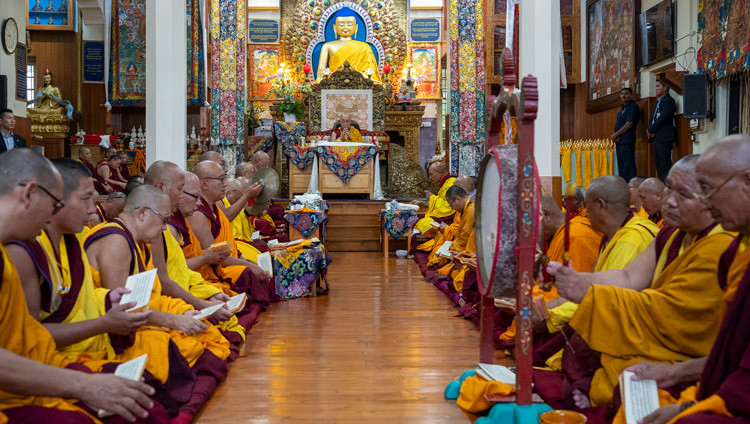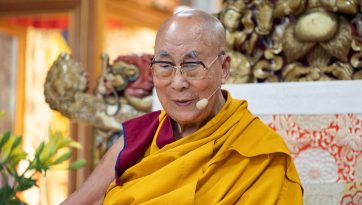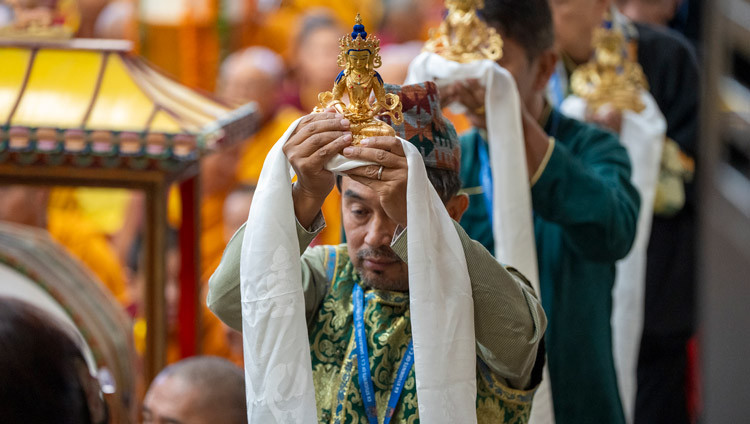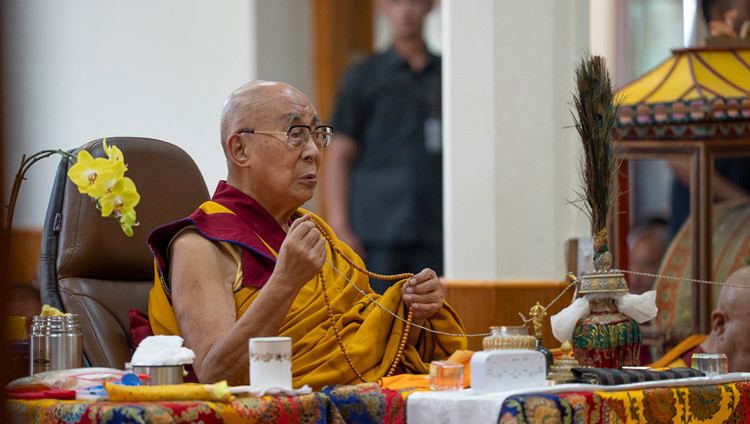Statement of Sikyong Dr. Lobsang Sangay on 23rd Anniversary of Conferment of Nobel Peace Prize to His Holiness the Dalai Lama
December 10, 2012
We are gathered here today to commemorate the 23rd anniversary of the conferment of the Nobel Peace Prize to His Holiness the Dalai Lama and the 64th anniversary of the International Human Rights Day. On this noteworthy occasion, the Kashag pays its obeisance to His Holiness the Dalai Lama and extends its warmest greetings to all Tibetans, friends and well wishers around the world.
The Norwegian Nobel Committee’s citation for the 1989 Nobel Peace Prize to His Holiness the Dalai Lama emphasized His Holiness’ opposition to the use of violence and his advocacy of peaceful solutions based upon tolerance and mutual respect. In the twenty-three years since receiving the Nobel Prize, His Holiness the Dalai Lama’s stature has attained such depth that his very name has become synonymous with compassion and non-violence. Tibetans are incredibly fortunate to have someone like His Holiness the Fourteenth Dalai Lama as our most revered leader.
On this occasion we must focus our attention and concern on the current crisis engulfing Tibet. With enormously sorrow, I report that a total of 95 Tibetans have self-immolated in Tibet since 2009. There were 12 self-immolations in Tibet in all of 2011 and 82 so far in 2012, including 28 in the month of November alone. Sadly, 80 of these Tibetans have died. What began in the heavily sentineled monasteries has spread as nomads, students and ordinary Tibetans in all three regions of Tibet (Amdo, Kham and U-Tsang) including Lhasa, the capital city of Tibet, join the swelling ranks of people willing to set themselves on fire to protest conditions in Tibet.
These tragic events in Tibet challenge in new ways a central assertion and rationalization of the Chinese government, namely, that Tibetans in Tibet are happy and content. For decades, against astronomical odds, Tibetans in Tibet have challenged this assertion and channeled their discontent in peaceful and myriad ways. After the tumultuous period of 1960s, from September 1987 to March 1989, Tibet again became front-page news when a series of major and non-violent protests erupted in Lhasa and neighboring Tibetan areas. At that time, Chinese security officials responded by imposing martial law and expelling all foreign journalists and tourists.
Later, in 2006, Tibetans gave up the use of fur of endangered animals and the world witnessed the extraordinary mass gatherings of Tibetans burning fur in public bonfires. Chinese authorities disapproved this show of Tibetan solidarity and, once again cracked down. Even so, celebrations over His Holiness the Dalai Lama receiving the U.S. Congressional Gold Medal in 2007 was not tolerated by the Chinese security forces in several Tibetan areas. In that same year, Rungye Adak, a Tibetan nomad, received an eight-year sentence for publicly calling for His Holiness the Dalai Lama’s return to Tibet. Other Tibetans were also given stiff prison sentences.
The year 2008 marked the time of the largest and most intense unrest as thousands of Tibetans from all walks of life protested against hardline Chinese policies. Hundreds were arrested, beaten, tortured and killed. These events cast a pall over the 2008 Beijing Olympics.
More recently, in addition to the fiery self-immolations, other forms of protests and displays of solidarity have occurred throughout Tibet. Tibetan students in Rebkong and Chabcha in Northeast Tibet took to the streets in thousands demanding protection of Tibetan language and equality. Clashes have erupted in different parts of Tibet against efforts to divert the flow of rivers and mining projects that have displaced large number of Tibetans. In a brave show of solidarity with the self-immolators, Tibetan teachers, government officials, writers, monks and businessmen began a three-day hunger strike on November 26 in Lhasa, Drakgo, Jomda, Dzachukha, Tridu, Serthar, Siling, Karze and Chengdu in China’s Sichuan Province. Another powerful development has been the Lhakar movement where every Wednesday thousands of Tibetans come together in formal and informal ways and take I-am-Tibetan pledges to speak, wear, eat and accentuate everything Tibetan.
The self-immolations are a continuation of a sustained non-violent Tibetan resistance against the occupation of Tibet and its repression of Tibetans. They, however, represent a new threshold of Tibetan despair and resentment, and a worsening of the vicious cycle of unrest-repression-more unrest. The Kashag attributes the self-immolation and current situation to the political and religious repression, economic marginalization, social discrimination, cultural assimilation and environmental destruction in Tibet.
Despite repeated appeals by the Central Tibetan Administration (CTA) to refrain from such drastic acts, Tibetan self-immolations persist. The universal demands of the Tibetans have been the return of His Holiness the Dalai Lama to Tibet and freedom for Tibetans. This is the precious hope of the people of Tibet. It is the responsibility of those of us fortunate to live in freedom to do all within our power to help bring the Tibetan demands to fruition. We, therefore, view it as a sacred duty to make the cries of the self-immolators and other protestors heard around the world.
Inevitably, the Chinese Communist Party has blamed the self-immolations on the exiled Tibetan leadership. But to blame His Holiness the Dalai Lama and the Tibetan Administration is a frank admission by the Chinese government of its utter failure to win the loyalty of Tibetans despite fifty plus years of occupation. It also reflects Beijing’s failure to engage in legitimate policy options, and to continue to rely, instead, on the blame game.
In my March 10, 2012 statement, I called on all Tibetans and friends to make 2012 a Tibet Lobby Year. This call, in conjunction with the dedicated work of Tibetans and Tibet support groups, has been a success as we have since seen significant official statements of support by many countries; resolutions in parliaments and congress in the European Union (EU), France, Italy and the United States; and statement by parliamentarians in Australia, Brazil, Canada, EU, France, Germany, Italy, India, Japan, South Africa and others.
The CTA expresses deep appreciation to the United Nations and various governments and parliaments for their attention to the deteriorating situation in Tibet.
The UN High Commissioner on Human Rights, Navi Pillay, recently issued an unprecedented call to Chinese leaders to urgently address the underlying grievances of the Tibetan people. “Social stability in Tibet will never be achieved through heavy security measures and suppression of human rights,” she said on November 2. Ms. Pillay appealed to the Chinese Government “to seriously consider the recommendations made to it by various international human rights bodies, as well as to avail itself of the expert advice being offered by the UN’s independent experts on human rights.”
We also welcome the recent comments made by Gary Locke, the US ambassador to China, who visited Tibetan areas in late September and implored “the Chinese to really meet with the representatives of the Tibetan people to address and re-examine some of the policies that have led to some restrictions and the violence and the self-immolations.”
On November 21, the Human Rights Commissioner of Germany urged the Chinese government to reform its policies and requested international observers be allowed to visit Tibet. On November 27, the French Senate adopted a resolution calling on the European Union to give priority to Tibet within the mandate of its recently appointed EU Special Representative for Human Rights.
The above actions by various governments and institutions are a welcome positive development. We urge all foreign governments engaging in Human Rights Dialogue with China to acknowledge that the situation in Tibet has worsened. We urge them, and the international community, to intervene to end the crisis in Tibet. If Beijing ends repression of Tibetans then the self-immolations will abate. The CTA remains steadfastly committed to the Middle-Way Approach and to the resumption of dialogue between Beijing and Dharamsala to resolve the issue of Tibet. The responsibility as well as the solution for the current crisis in Tibet lies with the Chinese government.
We appreciate the support of some of our Chinese friends and various Chinese NGOs based outside China, but remain deeply disturbed and saddened at the silence and seeming indifference of most Chinese people, particularly that of Chinese intellectuals and public thinkers, to the suffering of the Tibetan people. The Tibetan struggle is neither anti-China nor anti-Chinese people. What Tibetans seek is freedom and genuine autonomy as enshrined in the Chinese constitution. I appeal to our Chinese brothers and sisters to join us in supporting the aspirations of the Tibetan people.
Let us build on the successful lobbying efforts of 2012 by launching a Solidarity with Tibet campaign in 2013. I urge all Tibetan Associations, Tibet Support Groups, international NGOs, people of all faiths, and friends of justice to continue to lobby governments and parliaments for Tibet and the Tibetan people. Organize rallies and vigils particularly in capital and major world cities. Please call on the Chinese government to allow international media access into Tibet. Time magazine listed Tibetan self-immolations as one of the most underreported story of 2011. Let us alter that by reaching out to the media and encouraging them to write and broadcast about what is happening in Tibet.
Let us declare every 17th May as the Solidarity Day for Tibet. On that day in 1995, the six-year-old boy, Gendhun Choeky Nyima, who was recognized by His Holiness the Dalai Lama as the 11th Panchen Lama, was taken into custody by the Chinese authorities and has not been seen publicly since.
Also, the Kashag and the Tibetan Parliament-in-Exile will be jointly organizing a four-day program of rallies, presentations and other solidarity activities from January 30 to February 2, 2013 in New Delhi. Kalons, Tibetan parliamentarians and representatives from various Tibetan settlements will be participating.
In closing, the CTA offers its undying gratitude to the people and government of India for their generosity, hospitality and assistance to the Tibetan refugees for these many years. We also extend, on behalf of all Tibetans, profound appreciation to our old and new friends around the world. Your outspoken and resounding support is needed more than ever.
To our brothers and sisters in Tibet, we are with you every step of the way. The three principles of unity, innovation and self-reliance will guide us towards our goal of seeing His Holiness the Dalai Lama return to Tibet and restoring freedom for Tibetans.
Finally, the Kashag and I join the people of Tibet in wishing His Holiness the Dalai Lama continued good health. May all his wishes be fulfilled.




